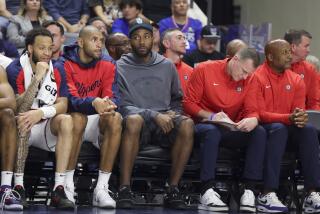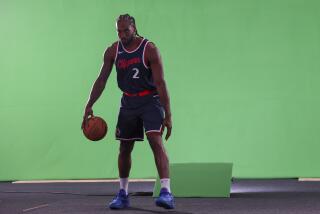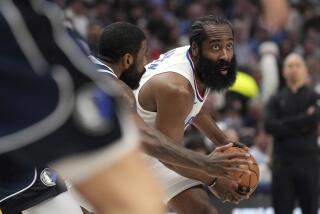As painful as it is to watch, just imagine his suffering
If you saw it happen in person at Staples Center, or saw the replay of Shaun Livingston’s injury Monday night, you knew right away.
It was bad. Ugly. Sickening.
For the record:
12:00 a.m. Feb. 28, 2007 For The Record
Los Angeles Times Wednesday February 28, 2007 Home Edition Main News Part A Page 2 National Desk 0 inches; 28 words Type of Material: Correction
Pro basketball: In Tuesday’s Sports section, a column about the injury to the Clippers’ Shaun Livingston described teammate Daniel Ewing as a rookie. Ewing is a second-year player.
For The Record
Los Angeles Times Saturday March 03, 2007 Home Edition Main News Part A Page 2 National Desk 1 inches; 51 words Type of Material: Correction
Livingston injury: An article and a column in Tuesday’s Sports section on the Clippers’ Shaun Livingston said he missed 52 games in his rookie season because of a dislocated right kneecap. Livingston missed 39 games that season because of the knee injury. He missed 13 games because of a shoulder injury.
A leg is not supposed to bend that way. A knee can’t take that sort of trauma and come back to doing all the things it is supposed to. And then, when the knee is supposed to do the things it must to be a player in the NBA, coming back becomes a huge issue.
Yes, that’s right. That’s the issue. Coming back at all. Or coming back with the same mobility it had before Monday night’s terrible misstep.
The replay made you wince like the Joe Theismann replay. Legs don’t go those directions without serious trauma. Theismann’s injury, a horror to watch, was a compound fracture.
Livingston didn’t break any bones, and his dislocated knee was slightly less horrifying to see but still bad enough for announcers to warn audiences before showing the replay. Doctors will soon know how many ligaments, tendons and arteries are damaged and what all that will mean to the future. In some cases, dislocations are worse than fractures. Much worse.
Livingston, a 21-year-old point guard and anchor of the Clippers’ plans for the future, got a loose ball with just over eight minutes to play in the first quarter. He dashed for the layup, with an opposing player nearby but not really threatening. Livingston had done this thousands of times, as a high school player and a pro prodigy. Yet when he landed, the left leg hit wrong and all the weight pushed his knee where no knee is meant to go.
The first thing you noticed is that he didn’t even try to get up. Athletes tend to be warriors, to do everything they can to get back in there. This time, any adrenaline suggesting that to Livingston was quickly erased by the pain.
If you watch enough sporting events, you will see something like this every once in awhile. It is always horrible.
Years ago, a football player from the University of Wisconsin named Pat Collins made a tackle on a cold day in Camp Randall Stadium in Madison. Suddenly, his screams could be heard in the press box, five stories above the field, through the closed windows, over the noise of more than 90,000 people. Collins had dislocated his ankle. As he screamed, he crawled face down, his foot pointing toward the sky. He found no relief until a doctor rushed onto the field and “reduced” the injury, a medical term for putting it back into the joint from where it moved.
That’s exactly what happened to Livingston. Steven Shimoyama, team physician filling in for Tony Daly this game and sitting right behind the Clippers’ bench, perhaps 10 yards away from where Livingston went down, knew what had happened and was on the floor in seconds. He “reduced” Livingston’s knee, and his description to the press of the details of that, the pulling and tugging, shall be left unsaid here in deference to those eating breakfast while reading.
In essence, Shimoyama, who learned how to do this while a trauma surgeon at USC Medical Center, has done it many times and was successful on Livingston on his first try.
“That alleviated nearly all his pain,” Shimoyama said. “When it was dislocated, he was in a lot of pain.”
Someday, when Livingston feels well enough to talk about this, he will probably call those words from Shimoyama the understatement of all time.
This is painful for the Clippers on many levels. Coach Mike Dunleavy saw it immediately, knew at once that his fallen player, just steps away from him, was seriously hurt. As the ball headed back to the Charlotte Bobcats’ end of the court -- Livingston had missed the layup -- Dunleavy tried to get the attention of the officials, tried to get play to stop. Mercifully, a Bobcats player yanked up a shot and the Clippers rebound brought an immediate timeout.
In an instant, Livingston was surrounded. Dunleavy got there, took a look and the blood appeared to drain from his face. Center Chris Kaman stood over Livingston like a protective big brother and stayed for a long time, even after Shimoyama got there and took over.
A stretcher arrived more quickly than anybody could ever remember one showing up. There was not one moment when all the activity and body language said that what had just happened wasn’t serious.
The road back will begin soon for the player whose name was bandied about in trade talk for the likes of Jason Kidd and Allen Iverson. He will have tests, and more tests. They will see how many ligaments will need repair, if any. The first thing they will check is whether the injury cut off the blood supply to any key arteries. If something like this happens in the jungle, away from medical care, and an artery is damaged, the result, according to Shimoyama, is gangrene in the injured leg.
Clippers officials, and Shimoyama, were careful to avoid predictions of the future, despite being pressed by reporters. At one point, Shimoyama even conceded that it was possible Livingston could make it back this season. He also said that the injury Livingston had two seasons ago, a dislocated right kneecap, was not as serious as Monday night’s dislocated left knee. After the kneecap injury, Livingston missed 52 games.
The trade deadline passed Thursday. Other point guards on the team are Sam Cassell, 37, and Daniel Ewing, in his second season.
The Clippers are a team scrambling for a playoff spot. They beat the Bobcats, 100-93, to make their record 27-29. It was their second straight win.
That still didn’t make it a good night.
Bill Dwyre can be reached at bill.dwyre@latimes.com. To read previous columns by Dwyre, go to latimes.com/dwyre.
More to Read
Get our high school sports newsletter
Prep Rally is devoted to the SoCal high school sports experience, bringing you scores, stories and a behind-the-scenes look at what makes prep sports so popular.
You may occasionally receive promotional content from the Los Angeles Times.








